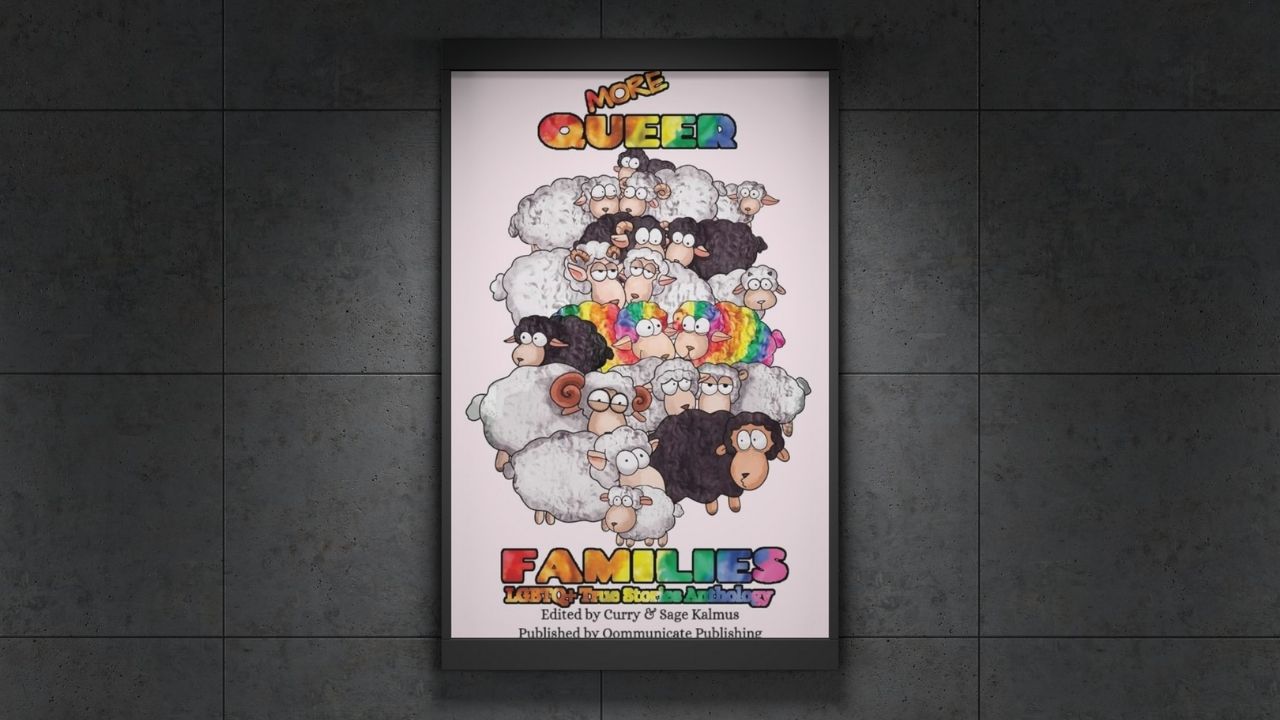In the tapestry of storytelling, few themes are as universally resonant as the idea of family. But for many in the LGBTQIA+ community, the concept of family often transcends bloodlines, evolving into something deeper and more intentional—found families. These chosen bonds, built on trust, mutual support, and unconditional love, strike a chord with individuals who have faced rejection, isolation, or the need to forge their own paths.
Fantasy stories, with their sweeping adventures and richly imagined worlds, provide the perfect backdrop for exploring found family dynamics. These tales often center on characters who are outcasts or misfits—those who band together to overcome challenges, save their worlds, and discover that their greatest strength lies in one another. This universal appeal becomes even more poignant when intertwined with LGBTQIA+ narratives, highlighting themes of acceptance, resilience, and identity.
This article delves into the powerful intersection of LGBTQIA+ representation and the concept of found families in fantasy literature. We’ll explore why this theme resonates so deeply with readers, spotlight some iconic stories that embody it, and discuss the broader significance of these narratives in fostering understanding and belonging.
The Importance of Found Families in LGBTQIA+ Representation
For many LGBTQIA+ individuals, the concept of found family is more than a narrative trope—it’s a lived reality. A “found family” refers to a group of people who choose to form deep, supportive bonds, often stepping in where biological families may not. These connections are rooted in mutual care, respect, and understanding, serving as lifelines for individuals navigating societal challenges or familial rejection.
Historically, the LGBTQIA+ community has faced significant barriers to acceptance, both socially and within traditional family structures. For decades, queer individuals have been disowned, ostracized, or forced to hide their identities to maintain relationships with their families. The AIDS crisis of the 1980s and 1990s highlighted the necessity and resilience of chosen families, as friends and partners became primary caregivers in the absence of familial support. Even today, while progress has been made, many LGBTQIA+ people still seek solace and validation outside of their biological families.
In fiction, found families serve as powerful reflections of these real-life dynamics. Fantasy stories, in particular, often depict groups of disparate individuals—outcasts, misfits, or strangers—coming together to form bonds that transcend blood. These narratives mirror the journey of LGBTQIA+ individuals in seeking and creating spaces where they are valued for who they truly are.
For example, the sense of belonging that a found family provides in fiction resonates deeply with readers who may have faced similar struggles. These stories validate the lived experiences of LGBTQIA+ individuals, offering hope and showing that love and acceptance are not confined to conventional definitions of family. By portraying characters who create their own support systems, these narratives celebrate the power of choice and the transformative nature of community.
Ultimately, found family themes in LGBTQIA+ representation are more than just heartwarming—they are affirmations of resilience and humanity, reminding us that families are not just inherited but built.
Why Fantasy Is the Perfect Genre for Found Family Narratives
Fantasy has long been celebrated as a genre of limitless possibilities, where readers and writers can escape the constraints of reality and immerse themselves in worlds shaped by magic, adventure, and wonder. For LGBTQIA+ individuals, this escapism offers more than just entertainment—it creates a space for exploring identity, belonging, and the transformative power of chosen connections.
At its core, fantasy thrives on the themes of quests and collaborative survival, often bringing together a diverse cast of characters who would otherwise never cross paths. Whether it’s an unlikely band of adventurers tasked with saving the world or a group of misfits navigating treacherous terrain, these narratives hinge on the development of trust, camaraderie, and loyalty. The trope of “found family” fits seamlessly within this framework, as characters gradually move from strangers or adversaries to allies and, ultimately, to a tightly-knit unit bound by mutual care.
This focus on unity amidst diversity parallels the real-life experiences of many LGBTQIA+ individuals. The journey to self-discovery and acceptance often involves overcoming societal prejudices and personal insecurities—challenges that are reflected in the fantastical struggles faced by fictional heroes. Magical worlds, with their trials and transformations, serve as metaphors for the growth and resilience required to embrace one’s identity and build meaningful relationships.
Take, for example, the archetypal fantasy quest: A young protagonist, ostracized for being “different,” sets out on a journey of self-discovery. Along the way, they encounter others who are similarly misunderstood, marginalized, or searching for a place to belong. Together, they overcome challenges, confront their pasts, and find strength in their shared experiences. For LGBTQIA+ readers, these narratives resonate deeply, offering both representation and a sense of hope that they, too, can find their tribe in the face of adversity.
Moreover, fantasy allows for the exploration of identity in ways that transcend the constraints of our reality. Characters can defy gender norms, wield powers that symbolize personal agency, or create new traditions and communities in defiance of oppressive systems. These elements make fantasy an ideal genre for imagining not just a better world, but one where chosen families and authentic identities are celebrated without question.
In essence, the genre’s limitless potential for creativity and its focus on unity amidst diversity make fantasy the perfect platform for found family narratives. By weaving LGBTQIA+ representation into these stories, writers can create compelling tales that resonate with readers from all walks of life, reminding us of the strength found in community and the transformative power of love and acceptance.
Iconic LGBTQIA+ Fantasy Stories Featuring Found Families
Fantasy literature has been home to some of the most poignant explorations of found family, with LGBTQIA+ narratives taking center stage in many beloved works. These stories not only showcase diverse representation but also delve into the power of chosen connections. Below are some standout examples where the themes of found family and LGBTQIA+ identities shine.
The House in the Cerulean Sea by TJ Klune
This heartwarming tale follows Linus Baker, a by-the-book caseworker who is sent to evaluate a magical orphanage housing “dangerous” children. As Linus grows closer to the children and their enigmatic caretaker, Arthur Parnassus, he discovers a sense of belonging he’s never felt before.
- Found Family Theme: The children, who each face societal rejection, form a tight-knit family under Arthur’s care. Linus’s journey highlights how love and acceptance can transform lives.
- LGBTQIA+ Representation: Arthur and Linus’s budding romance unfolds gently, reinforcing themes of love and hope.
The Priory of the Orange Tree by Samantha Shannon
This epic fantasy centers on a divided world facing the resurgence of an ancient dragon. Amid the political intrigue and magical battles, characters from different backgrounds come together to save their world.
- Found Family Theme: The diverse cast—including a dragon rider, a mage, and a queen—forms alliances that transcend societal and personal divides.
- LGBTQIA+ Representation: The story features a beautifully written sapphic romance between Ead Duryan, a mage, and Queen Sabran Berethnet, showcasing the depth and complexity of LGBTQIA+ relationships in a high-stakes narrative.
Gideon the Ninth by Tamsyn Muir
In this gothic space-fantasy, Gideon Nav reluctantly teams up with her nemesis, Harrowhark Nonagesimus, to compete in a deadly trial for power and survival. The story blends necromancy, snarky humor, and deep emotional connections.
- Found Family Theme: The relationship between Gideon and Harrow evolves from animosity to profound reliance, showcasing the messy, imperfect nature of chosen bonds.
- LGBTQIA+ Representation: Gideon’s queerness is unapologetically central to her character, and the story’s subtext teems with LGBTQIA+ undertones.
Carry On by Rainbow Rowell
This magical school story follows Simon Snow, a “chosen one” who struggles with his destiny, his friendships, and his complicated relationship with his roommate, Baz.
- Found Family Theme: Simon’s group of misfit friends supports him through his trials, creating a family unit that feels authentic and fiercely loyal.
- LGBTQIA+ Representation: The romance between Simon and Baz provides a tender, nuanced exploration of queer love in a fantastical setting.
Black Water Sister by Zen Cho
This urban fantasy blends Malaysian folklore with a gripping story about family, identity, and self-discovery. Jessamyn Teoh, a closeted lesbian, becomes entangled with a vengeful deity when she moves back to Malaysia.
- Found Family Theme: Jess’s journey highlights the intersection of chosen and inherited family, as she reconciles her cultural heritage with her identity.
- LGBTQIA+ Representation: Jess’s struggles with her sexuality and her relationship with her girlfriend are woven seamlessly into the narrative.
Diversity in Representation
These stories showcase a wide array of LGBTQIA+ identities, including gay, lesbian, bisexual, and nonbinary characters. Moreover, they reflect diversity beyond sexuality, featuring characters of different races, cultural backgrounds, and experiences. This intersectionality enriches the narratives, making them more relatable to readers from various walks of life.
By spotlighting LGBTQIA+ characters in found family dynamics, these fantasy tales offer powerful messages of hope, acceptance, and resilience. They remind us that, in the face of adversity, it is often the families we choose that become our greatest source of strength.
The Emotional Impact on Readers
The profound emotional impact of LGBTQIA+ fantasy stories featuring found families lies in their ability to resonate deeply with readers, offering both a mirror and a window into diverse experiences. These narratives evoke a powerful connection by blending universal themes of love and belonging with representation that speaks directly to the lived realities of LGBTQIA+ individuals.
Personal Testimonials and Reader Connections
Readers frequently share how these stories have touched their lives, with testimonials and reviews highlighting the comfort, hope, and joy these narratives bring. Many LGBTQIA+ readers describe the sense of relief in seeing characters like themselves finding acceptance and thriving in fantastical worlds.
For instance, fans of The House in the Cerulean Sea often praise its gentle, affirming tone, with one reader writing, “This book felt like a warm hug—it reminded me that even in a world that feels unkind, there’s always hope for love and community.” Similarly, The Priory of the Orange Tree has been celebrated for its unapologetic portrayal of queer love, with readers expressing gratitude for a sapphic romance that is central to an epic fantasy plot.
These stories often help readers feel seen, understood, and validated in ways they may not have experienced in other media. For many, they offer a safe space to explore identity, process emotions, and imagine a future where they can find their own found families.
Representation as Validation
The inclusion of LGBTQIA+ characters in found family narratives provides a form of validation that goes beyond mere acknowledgment. It shows readers that their identities are worthy of love, respect, and heroic narratives. These stories dismantle harmful stereotypes and challenge the notion that queer characters must endure tragedy to be significant.
For LGBTQIA+ readers, representation can feel like a lifeline. Seeing characters who share their struggles and triumphs fosters a sense of belonging and normalizes their experiences. Whether it’s a nonbinary dragon rider in a high-stakes battle or a gay protagonist navigating magical politics, these portrayals affirm that queer identities can exist—and thrive—everywhere, even in the most fantastical of worlds.
Broader Impact on Allies and Non-LGBTQIA+ Readers
The emotional resonance of these stories extends beyond LGBTQIA+ readers, offering allies and non-LGBTQIA+ individuals a deeper understanding of the importance of chosen families. Through these narratives, allies gain insight into the challenges of rejection, the strength of resilience, and the beauty of unconditional acceptance.
For many, these stories serve as a bridge to empathy. By immersing themselves in the struggles and triumphs of LGBTQIA+ characters, non-queer readers can develop a more nuanced perspective on identity and inclusion. As one reviewer noted about Gideon the Ninth, “This book made me laugh, cry, and root for characters whose experiences I could never fully understand but came to deeply respect.”
Ultimately, these stories have a unifying effect, showing readers from all backgrounds the universal need for love, belonging, and connection. By celebrating diversity and chosen families, LGBTQIA+ fantasy narratives foster empathy, hope, and the belief that everyone deserves a place to call home.
Challenges and Opportunities in Writing LGBTQIA+ Found Families
Creating authentic and compelling LGBTQIA+ found family narratives in fantasy is both a rewarding and intricate endeavor. While these stories have the potential to deeply resonate with readers, achieving meaningful representation requires care, nuance, and a commitment to avoiding common pitfalls.
Common Pitfalls to Avoid in Representation
- Tokenism and One-Dimensional Characters
- One of the most prevalent mistakes in LGBTQIA+ representation is the inclusion of queer characters solely for the sake of diversity. Token characters often lack depth, agency, or meaningful contributions to the story, reducing them to stereotypes or plot devices. To craft genuine found family dynamics, all characters—especially LGBTQIA+ ones—should be fully realized, with unique motivations, personalities, and arcs.
- Over-reliance on Trauma Narratives
- While it’s important to acknowledge the challenges LGBTQIA+ individuals face, focusing excessively on trauma can reduce characters to their struggles. Found family stories should balance hardship with joy, triumph, and the beauty of chosen connections, ensuring that LGBTQIA+ characters are defined by more than just their pain.
- Homogenization of LGBTQIA+ Identities
- LGBTQIA+ experiences are incredibly diverse, encompassing different genders, sexualities, cultural backgrounds, and intersections. Reducing characters to a single, monolithic identity ignores this diversity and risks alienating readers. Inclusive narratives should reflect a range of experiences, avoiding clichés and broad generalizations.
The Importance of Sensitivity Readers and Authentic Storytelling
Authenticity is key to writing LGBTQIA+ found family narratives that resonate. Authors who don’t share the lived experiences of their characters should approach these stories with humility, research, and a commitment to accuracy.
- Sensitivity Readers: These individuals provide invaluable insights into the authenticity of LGBTQIA+ representation, helping authors avoid unintentional biases, stereotypes, or inaccuracies. Their feedback ensures that characters and narratives are respectful and relatable.
- Research and Community Engagement: Immersing oneself in LGBTQIA+ literature, interviews, and firsthand accounts can deepen understanding and inform more nuanced storytelling. Listening to the voices of LGBTQIA+ individuals is crucial for creating characters and dynamics that feel genuine.
By prioritizing authenticity, authors can craft stories that resonate not just with LGBTQIA+ readers but with all audiences seeking meaningful, inclusive representation.
Opportunities for New and Emerging Authors
The fantasy genre is rich with possibilities for exploring LGBTQIA+ found families, and there is a growing appetite for fresh voices and perspectives. Emerging authors have the opportunity to redefine the genre by challenging traditional tropes and expanding the boundaries of representation.
- Blending Genres
- Combining fantasy with elements of science fiction, romance, or historical fiction can create unique narratives that appeal to diverse audiences. These hybrid stories provide new ways to explore identity and chosen connections.
- Exploring Intersectionality
- Incorporating characters who navigate multiple identities—such as LGBTQIA+ individuals from diverse cultural or religious backgrounds—adds depth and realism to found family narratives. Authors who embrace intersectionality can create stories that reflect the richness of real-world experiences.
- Championing Hope and Joy
- While conflict is essential to storytelling, there is an increasing demand for narratives that focus on joy, healing, and triumph. Found family stories are inherently hopeful, offering authors a chance to create uplifting tales that celebrate love, acceptance, and resilience.
Writing LGBTQIA+ found families in fantasy is both a challenge and an opportunity to contribute to a growing body of inclusive literature. By avoiding tokenism, embracing authentic storytelling, and exploring new perspectives, authors can create narratives that resonate with readers and leave a lasting impact. For writers willing to approach this subgenre with care and creativity, the possibilities are as limitless as the worlds they imagine.
Recommendations for Further Reading
For readers eager to explore LGBTQIA+ fantasy stories that celebrate found families, here’s a curated list of books, graphic novels, and short stories. These works range from mainstream hits to hidden gems, offering a variety of styles, perspectives, and voices.
Books
- The Long Way to a Small, Angry Planet by Becky Chambers
- This space-fantasy follows the crew of the Wayfarer, a diverse group of humans and aliens who form deep bonds as they travel the galaxy.
- Why It Stands Out: A heartfelt exploration of chosen family and identity, with strong LGBTQIA+ representation, including nonbinary and queer characters.
- Silver in the Wood by Emily Tesh
- A lyrical novella about a reclusive forest guardian and the charming folklorist who changes his life.
- Why It Stands Out: Combines queer romance with themes of belonging and the quiet power of connection.
- A Psalm for the Wild-Built by Becky Chambers
- A tea monk and a sentient robot navigate a post-apocalyptic world together, questioning existence and finding comfort in each other.
- Why It Stands Out: Explores nonbinary identity and the beauty of companionship in an uplifting, introspective tale.
- Empress of Salt and Fortune by Nghi Vo
- Through the eyes of a nonbinary cleric, this novella recounts the life of an exiled empress who builds her own support network in the face of adversity.
- Why It Stands Out: Weaves themes of resilience and loyalty into a richly crafted fantasy world.
- The Fifth Season by N.K. Jemisin
- In a world on the brink of collapse, three women of different backgrounds and struggles are drawn together by shared destinies.
- Why It Stands Out: Features complex characters, including LGBTQIA+ individuals, and highlights the strength of chosen bonds amidst societal upheaval.
Graphic Novels
- Heartstopper by Alice Oseman
- While more contemporary than fantastical, this graphic novel series follows the tender love story between two boys and the close-knit group of friends that supports them.
- Why It Stands Out: A heartwarming portrayal of LGBTQIA+ relationships and chosen families.
- On a Sunbeam by Tillie Walden
- This sci-fi graphic novel follows a crew that repairs abandoned structures in space, focusing on their interpersonal relationships and a queer love story.
- Why It Stands Out: A visually stunning narrative about connection, love, and building a family among the stars.
- The Witch Boy by Molly Knox Ostertag
- A middle-grade fantasy about a boy breaking magical gender norms and finding support among friends and family.
- Why It Stands Out: Perfect for younger readers, this story celebrates diversity and acceptance.
Short Stories and Anthologies
- All Out: The No-Longer-Secret Stories of Queer Teens Throughout the Ages edited by Saundra Mitchell
- A collection of historical and fantastical short stories that explore queer identities across time and space.
- Why It Stands Out: Diverse voices and genres make this anthology a treasure trove of representation.
- The Seafarer’s Kiss by Julia Ember
- A queer retelling of The Little Mermaid, featuring a mermaid who forms alliances to defy oppressive systems.
- Why It Stands Out: Combines myth, rebellion, and a compelling sapphic love story.
- A Spindle Splintered by Alix E. Harrow
- A subversive reimagining of Sleeping Beauty, where a young woman discovers connections with others who share her fate.
- Why It Stands Out: Merges queerness, fairy tales, and found family themes.
Indie and Lesser-Known Works
- Mooncakes by Suzanne Walker and Wendy Xu
- A graphic novel about a young witch and her werewolf best friend who reconnect and battle dark forces together.
- Why It Stands Out: A gentle, cozy story featuring queer protagonists and themes of love and support.
- The Bone Shard Daughter by Andrea Stewart
- In a crumbling empire, a young woman, a smuggler, and a magical creature must navigate their roles in reshaping the world.
- Why It Stands Out: Includes queer characters and highlights themes of trust and unity.
- Pet by Akwaeke Emezi
- A surreal story set in a world without monsters—until a child and their creature uncover hidden truths about their community.
- Why It Stands Out: Features a nonbinary protagonist and examines the complexities of identity and family.
This list offers something for every reader, from epic sagas to intimate character-driven tales. Whether mainstream or indie, these works celebrate the diversity and beauty of LGBTQIA+ found families, inspiring readers to embrace connection, resilience, and the power of chosen bonds.
Conclusion
Found families in LGBTQIA+ fantasy stories hold a unique and powerful significance. They provide a space where love, acceptance, and resilience flourish, offering readers both representation and inspiration. These narratives remind us that belonging isn’t always tied to biology or tradition—it can be created, nurtured, and chosen.
By delving into these tales, readers experience the joy and healing that found families bring, not just to the characters but to everyone who sees themselves reflected in their struggles and triumphs. For LGBTQIA+ individuals, these stories affirm their identities and celebrate their resilience. For allies and non-LGBTQIA+ readers, they offer empathy and understanding, fostering a broader appreciation for diversity and inclusion.
Call to Action Explore the rich world of LGBTQIA+ fantasy stories and support authors who champion diverse narratives. Whether you’re picking up a beloved classic or discovering a hidden gem, your engagement helps ensure that these vital stories continue to flourish.
Final Thought At their core, found family narratives in fantasy capture the universal quest for connection and belonging. They remind us that even in the most fantastical settings, the bonds we create and the love we share are profoundly real. Through these stories, we celebrate the enduring truth that family is not just something we’re born into—it’s something we choose and build together.




